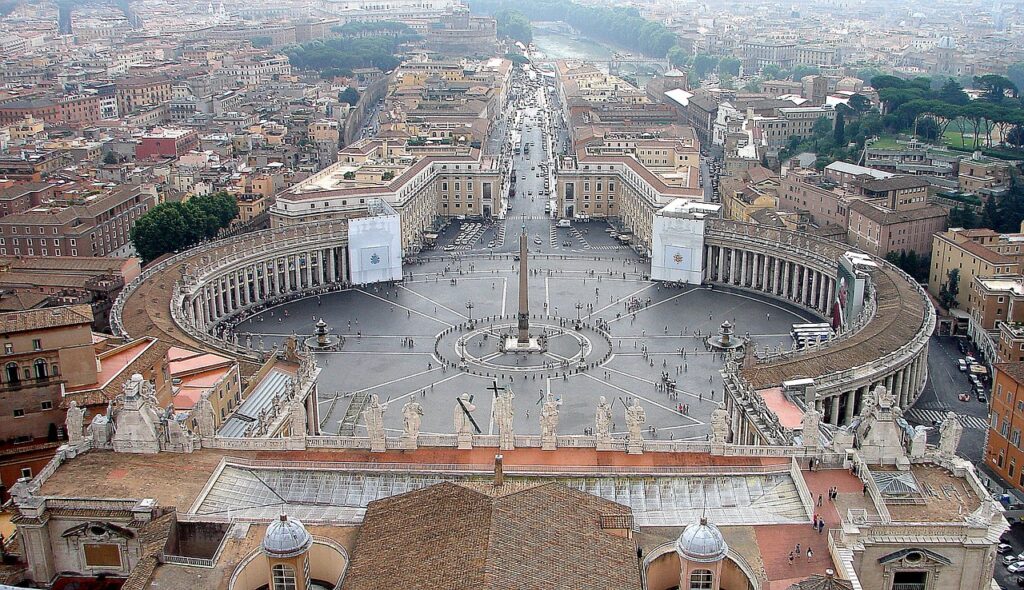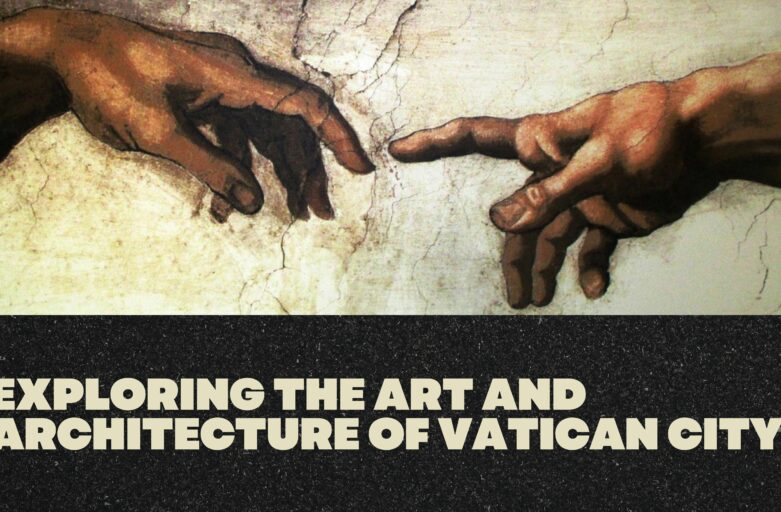The Vatican City is a tiny sovereign state located in the heart of Rome. It is the world’s smallest state by area, but it holds some of the most precious treasures of art and architecture in the world. The Vatican is not just a religious destination but also a cultural one. The art and architecture found within its walls are breathtaking and awe-inspiring. In this article, we’ll take a closer look at the art and architecture of the Vatican and provide a guide for exploring it.
The architecture of Vatican City
The architecture of the Vatican is a testament to the grandeur and richness of the Catholic Church. The Vatican’s architectural style is a blend of different periods, including Renaissance, Baroque, and Neoclassical.
The most prominent feature of the Vatican’s architecture is St. Peter’s Basilica, which is one of the largest and most famous churches in the world. St. Peter’s Basilica was designed by several famous architects, including Michelangelo and Bernini. The church’s grandeur is awe-inspiring, with its massive dome towering over the surrounding buildings. The interior of St. Peter’s Basilica is equally impressive, with intricate mosaics and beautiful sculptures adorning the walls and ceilings.
The Vatican is also home to other impressive architectural structures, including the Sistine Chapel and the Apostolic Palace. The Sistine Chapel is renowned for its stunning ceiling frescoes painted by Michelangelo, while the Apostolic Palace is the official residence of the Pope. The palace’s architecture is a blend of Renaissance and Baroque styles, with its grand staircases and ornate halls.
The Vatican also has a unique architectural feature in the shape of St. Peter’s Square. The square is a large plaza that is surrounded by colonnades and has an oval shape, reminiscent of a keyhole. The design of St. Peter’s Square is meant to symbolize the welcoming nature of the Catholic Church, with the open arms of the colonnades embracing visitors.

Interestingly, the shape of the keyhole is also found in other important buildings in Washington DC, which is no coincidence, as the design was influenced by the Vatican’s architecture.
The art of Vatican City
Vatican City is home to some of the world’s most famous art museums. The Vatican Museums house an extensive collection of art that spans from ancient times to the present day. The museum contains over 70,000 pieces of art, and it is impossible to see them all in one visit. The most famous piece of art in the Vatican Museum is the previously-mentioned Sistine Chapel, which is a masterpiece of Michelangelo. The Chapel is a must-see for anyone visiting the Vatican.
If you’re planning a visit to the Vatican, almost wherever you turn there is an attraction that is filled with art. However, here is a curated list to help you make sure you don’t miss anything important:
- St. Peter’s Basilica – The centerpiece of Vatican City is St. Peter’s Basilica. This stunning church is home to many works of art, including Michelangelo’s “Pietà” and Bernini’s “Baldacchino,” a towering bronze canopy over the altar.
- Vatican Museums – The Vatican Museums house an incredible collection of art, including the famous Sistine Chapel ceiling painted by Michelangelo. Other highlights include Raphael’s frescoes in the Raphael Rooms, the ancient Greek sculpture “Laocoön and His Sons,” The Belvedere Torso and the stunning Gallery of Maps.
- St. Peter’s Square – The square in front of St. Peter’s Basilica is a work of art in itself, featuring two fountains and an obelisk surrounded by a colonnade designed by Bernini.
- The Vatican Gardens – The Vatican Gardens are a peaceful retreat in the heart of Vatican City. The gardens feature sculptures, fountains, and beautiful landscaping.
- The Vatican Pinacoteca – This gallery features a collection of paintings by some of the greatest artists in history, including Caravaggio, Raphael, and Leonardo da Vinci.
- The Borgia Apartments – These apartments were decorated in the late 15th century for Pope Alexander VI and feature stunning frescoes by Pinturicchio and his workshop.
- The Pauline Chapel – This chapel features two large frescoes by Michelangelo, “The Conversion of Saul” and “The Crucifixion of St. Peter.” The chapel is often overlooked by visitors, but it is definitely worth a visit.
- The Vatican Library – The Vatican Library is one of the oldest and most important libraries in the world, housing over 1.1 million books and manuscripts, including some of the oldest known copies of the Bible.
- The Apostolic Palace – The Apostolic Palace is the official residence of the Pope and features beautiful frescoes and sculptures, as well as a stunning view of St. Peter’s Square from the balcony.
- The Vatican Necropolis – This underground burial site contains the tombs of several popes and is considered one of the most important archaeological sites in Vatican City.
It goes without saying that the works of art mentioned above represent just the tip of the iceberg. Be sure to take your time and explore all that Vatican has to offer, although touring ALL the art masterpieces in the Vatican is simply impossible by just visiting once. There’s just too many of them and besides, some of them are displayed by rotation.
While the Vatican has an extensive collection of art, not all of it is beautiful or uplifting. Some of the art within the Vatican is downright creepy. The Museum of Pio Clementine (part of the Vatican Museums) has a collection of ancient statues that include some rather disturbing figures. For example, there is a statue of a man being flayed alive. The statue is a testament to the Roman fascination with death and torture.
The Vatican also has a modern art collection, which is less well-known but just as impressive. The collection includes works by Picasso, Dali, and Matisse, among others. The modern art collection is located in the Vatican’s Contemporary Art Museum.
The Vatican is home to many famous pieces of art, but many wonder how does the Vatican store its art? The answer is simple: The Vatican has an extensive network of storage rooms that house its art collection. The rooms are temperature and humidity controlled to ensure the art remains in good condition.
The Vatican has acquired its art collection over many centuries. Some of the art was donated to the Vatican by wealthy patrons, while other pieces were acquired through conquests. For example, during the sack of Constantinople in 1204, the Vatican acquired many Byzantine treasures.
Touring the Vatican’s art masterpieces can be overwhelming, but it is possible to see some of the most famous works in a single visit. Some of the must-see works include Michelangelo’s Pieta and Raphael’s Transfiguration. Visitors should also take time to appreciate the ceiling art in the Vatican’s various galleries, including the Gallery of Maps and the Gallery of Tapestries.
One question that many visitors may have is how the Vatican pays for the art that needs restoration. The Vatican’s art restoration program is funded by a combination of government grants, private donations, and revenue from ticket sales to the Vatican Museums. The Vatican’s restoration program is one of the most important in the world, and it has helped to preserve many priceless works of art for future generations to enjoy.
The value of the art in the Vatican is impossible to calculate. However, it is estimated to be worth billions of dollars. The Vatican is not just a religious institution; it is also a cultural and historical one.
Because it played such an important cultural and religious role in the world, the Vatican was seen by the general public as an institution that has great power, wealth and influence. Whether we are talking about ancient artifacts, certain practices conducted behind closed doors or the Pope itself, controversies never ceased to follow the Vatican. It has always been the subject of many myths and misconceptions over the years. Some people are attracted to visit the Vatican precisely by the idea of being in the proximity of so many well-kept secrets.
The price of admission to the Vatican Museums is well worth the experience of seeing the vast collection of art and artifacts that the Vatican has to offer. The Vatican Museums’ ticket price varies depending on the type of ticket purchased and the time of year, but it is generally around 17 to 21 Euros for adults.
Wrapping up
In conclusion, the Vatican is a cultural and historical treasure trove that is well worth exploring, even if you find yourself in Rome only for a city break.. Its art and architecture are breathtaking and offer visitors a glimpse into the rich history of the Catholic Church and Western civilization as a whole. Whether you’re interested in ancient art or modern, the Vatican Museums have something to offer everyone. So next time you’re in Rome, be sure to visit the Vatican and experience the beauty and wonder of its art and architecture for yourself.
Frequently asked questions
Why does St. Peter’s Square have the shape of a keyhole?
The keyhole shape of the St. Peter’s Square is one of the most famous architectural features of the Vatican. It is a symbol of the welcoming nature of the Catholic Church. The colonnades look like they are embracing visitors and believers.
How many art objects are in Vatican’s collection?
It is difficult to estimate the exact number of art objects that the Vatican has, as the collection is vast and constantly growing. However, it is believed that the Vatican has one of the largest and most important collections of art in the world, with estimates ranging from 70,000 to 100,000 works of art. The collection includes paintings, sculptures, frescoes, tapestries, and other objects from various periods of history, from ancient times to the present day.
Despite the vastness of the Vatican’s art collection, only a small fraction of it is on display at any given time. Many of the works are kept in storage to protect them from damage, and only a select few are rotated through the Vatican Museums’ various galleries and exhibitions.
How does the Vatican store its art?
The Vatican has a state-of-the-art storage facility, known as the Vatican Apostolic Archive, where many of the works of art are kept. The archive is located within the Vatican City and is equipped with climate-controlled rooms, fire suppression systems, and advanced security measures. The works of art are stored in specially designed crates or containers, which protect them from damage during transport and storage. The containers are made from materials that are chemically stable and do not react with the artworks.
The artworks are also placed on specially designed supports that keep them stable and prevent any movement that could cause damage. In addition to the Vatican Apostolic Archive, the Vatican also has several other storage facilities, including the Vatican Library and the Vatican Museums’ storage rooms. These facilities are also equipped with climate-controlled rooms and advanced security systems to ensure the artworks’ preservation.
Where did the Vatican get so much art?
The Vatican’s art collection has been amassed over centuries, and many of the works were acquired through donations, gifts, or purchases. The collection includes works from various periods of history, from ancient times to the present day, and includes pieces from different regions and cultures.
Some of the earliest works in the Vatican’s collection were acquired during the Renaissance period, when many wealthy patrons commissioned artists to create works of art for the Church. Popes and cardinals also played a significant role in acquiring artworks, commissioning artists to create works for their personal collections or the Church.
In addition to commissioning works of art, the Vatican also received many donations and gifts of art from wealthy individuals and rulers. These gifts were often given as a sign of respect or devotion to the Church, and many of the works were of significant cultural or historical value.
